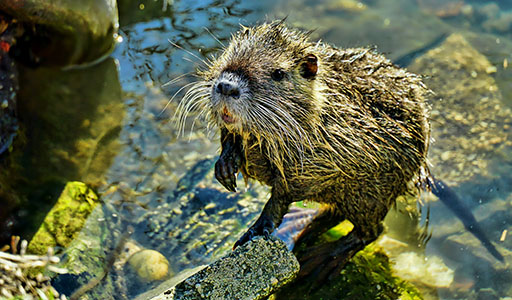Nutria Pest Control
Do you need to get rid of nutria? We can help!

Nutria Removal Strategies
The professionals of Trutech have the experience needed to handle nutria capture and removal safely and securely. You shouldn’t have to fret overexposing nutria nests or building tall structures to deter them. We’ve spent years developing state-of-the-art techniques and tricks that we can implement with ease, so you never have to worry.
Here at Trutech, we’re proud of our commitment to ethically and environmentally sound solutions to any and all wildlife infestations. We care about all creatures, which is why we make sure our methods of nutria control are humane and have minimal impact on the ecosystem. If you have a nutria problem, don’t hesitate to reach out to Trutech today. We want to lend you a helping hand.
Nutria Pest Problem

Signs Nutria is on Your Property
The semiaquatic coypu, or nutria, is considered an invasive species. Once coveted in the United States for their fur, these rodents have since become a collective menace to local ecosystems. They’ve wreaked havoc on the wetlands of the Gulf Coast; their large appetites have left areas almost devoid of vegetation, and their burrows can cause lasting damage to the land and man-made structures. Nutria can be detrimental to a homeowner’s yard, or any outdoor area thriving with plant life, and the legal protections nutria have been granted in many states make the already complex solutions to dealing with these creates nearly impossible to carry out efficiently. That’s why you should call Trutech.

Dangers of Nutria Infestation
Since their introduction, nutria have steadily eroded the fragile wetland ecosystems around the United States. Their voracious appetites and large numbers leave their habitats completely stripped of vegetation, prompting erosion and destroying shelter and food sources that many native creatures rely on. Their burrows also weaken the soil and damage natural or man-made dams, dikes, and embankments. Additionally, diseases, such as tularemia and giardia, are transmitted by nutria and can affect both humans and pets.
Humane Nutria Pest Removal & Control Strategies

Entry into property
Although powerful swimmers, nutria are awkward walkers and shuffle about with a hunched posture as they forage for food on land. For this reason, it is rare to see the creatures in yards or near homes unless private properties stand very close to the water’s edge or are located near streams, lakes, or wetlands.

Trapping & Removal
In some states nutria are considered important fur-bearing animals and receive legal protection, while in others they are simply considered nuisances. To avoid legal retribution, individuals should contact wildlife control specialists to handle infestations. The professionals at Trutech have the experience and knowledge necessary to humanely and legally handle populations of nutria.

Prevention & Exclusion
Nutria are not good climbers, and can be excluded from areas with sturdy fences. To be most effective, fences should be buried at least a foot underground and stand three feet tall. As the rodents prefer to dig their burrows into steep banks near rivers or marshes, modifying the angle of inclination by digging or piling additional dirt onto coasts may make environments less attractive. Upon discovering established nutria burrows, partially expose the nests or fill entrances with loose soil to push the rodents into moving elsewhere.


